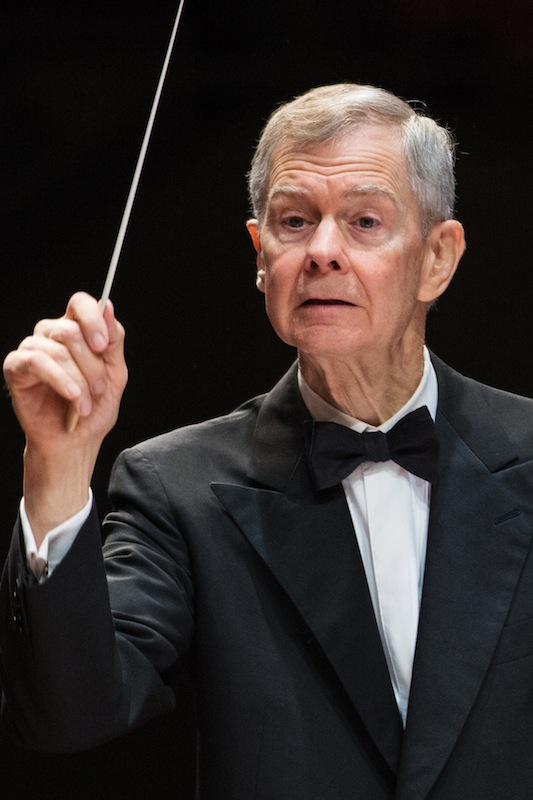A new look at Bruckner’s Third from the New England Philharmonic

Richard Pittman conducted the New England Philharmonic Saturday night at the Tsai Performance Center.
There is a prevailing belief that final versions of works are the most authoritative. But when it comes to Bruckner’s Symphony No. 3, critical opinions vary as to which of its many versions are best.
Questions over the dramatic effectiveness of Bruckner’s early conceptions hung in the air at the Tsai Performance Center Saturday night, when Richard Pittman led the New England Philharmonic in a recently realized 1876 edition of the Third Symphony.
Bruckner completed the score in 1873, but revised it several times over the next decade and a half, cutting its numerous quotations from Wagner’s Tannhäuser, Lohengrin, and Tristan und Isolde. This and subsequent versions have been recorded numerous times, but none more so than the 1889 edition, which is widely seen as definitive.
But Bruckner biographer Erwin Doernberg argued that the final version, completed with the help of the composer’s students, robs the symphony of its symmetry, the finale’s peroration coming too abruptly.
William Carragan, Vice President of the Bruckner Society of America who served as consultant for Saturday’s performance, tends to agree. After combing through the archives, Carragan helped restore the Third Symphony to an expanded 1876 form, which includes thirty-eight measures the composer cut from the finale the following year. Saturday night’s performance served as its belated world premiere.
Appearing midway through the finale, the newly discovered measures don’t distort Bruckner’s sprawling structure. Rather, they combine themes in a way the composer never explored in any other symphony. After a bold restatement of the work’s opening trumpet call, the trumpets and trombone sound out a chorale over cascading string accompaniment derived from the first theme of the finale. Including this stretch of music may seem trivial on the surface, but these measures bring about a heightened sense of resolve by foreshadowing the return of the opening theme, which, in the popular 1889 version, can seem forced by the symphony’s conclusion.
A committed Brucknerian, Pittman led a performance well suited to this subtle architectural shift, and his fleet tempos, especially in the finale’s polka, brought vitality.
The performance wasn’t note perfect. Tentative entrances after the symphony’s dramatic pauses robbed the music of requisite intensity, and the contrapuntal lines of the second movement lacked clarity. The exposed violin phrases in the outer movements also wavered in and out of tune.
But such sins are forgivable given the chamber-like delicacy the musicians evinced through this performance. Saturday’s reading remained an engrossing and intimate unveiling of Bruckner’s music, with the Scherzo’s themes taking on demonic energy and the Trio’s ländler coursing with bucolic verve. In the lyrical sections of the second movement, the strings sounded with enveloping warmth. The pauses had enough tension to carry the listener forward, and the climactic passages erupted with conviction.
Pittman and the orchestra opened the program with Melinda Wagner’s Proceed, Moon.
Commissioned by the Chicago Symphony Orchestra and premiered by that ensemble under the direction of Susanna Mälkki in June 2017, Wagner’s score wrestles with loss and resulting grief.
The title is a reference to a quote from Shakespeare’s A Midsummer Night’s Dream, but Wagner’s music conveys no specific program. At eighteen minutes, Proceed, Moon, heard in its Boston premiere, can feel overly long, but it is packed with luminous effects that keep the listener’s attention. Scored for massive forces—including a large percussion arsenal—the work begins softly. Opening string tremolos evolve into restless passages that convey a sense of mystery. As the music progresses, the lines freeze into thorny dissonances before fading to a shimmering conclusion.
Proceed, Moon ends in quiet reflection of personal tragedy. The final bars include a sample from a 1965 recording of Handel’s “Where’er You Walk,” sung by the Swarthmore Elementary School Choir under the direction of Wagner’s music-teacher mother, who died in 2013. Though a little contrived, the ending manages to bring a heartwarming conclusion to this bracing composition.
Pittman led a reading marked by both power and delicacy, and the New England Philharmonic sounded vastly improved here, strong in all sections. Winds and strings provided bright contrast to the ensemble’s weighty brass, and the many angular passages that course through Proceed, Moon moved elegantly.
Before intermission, pianist Randall Hodgkinson and Leslie Amper joined the NEP for Poulenc’s Concerto for Two Pianos and Orchestra.
A husband-and-wife duo, Hodgkinson and Amper possess brilliant technique in equal measure. Playing with bell-toned articulation in the first movement, each traded dazzling lines with the other. Their twinkling passages at movement’s end—the composer’s recreation of Balinese gamelan music—resulted in moments of eerie stasis.
Both pianists charted the finale’s knuckle-busting phrases with vigor. And in the second movement, the duo shaped each lyrical line with gentle rubato, the music flowing in singing, almost Mozartean arcs.
With brisk, waving gestures, Pittman mined the humor from this concerto, the orchestra’s bold tutti attacks and biting countermelodies a fitting complement to the crystalline playing of the soloists.
Richard Pittman will lead the New England Philharmonic in music by Berlioz, Wyner, Slater, Janáček, and Rakowski 8 p.m. April 27 at the Tsai Performance Center. nephilharmonic.org
Posted in Performances





Posted Mar 04, 2019 at 10:21 am by A new look at Bruckner’s Third from the New England Philharmonic – New England Philharmonic
[…] Original Article: A new look at Bruckner’s Third from the New England Philharmonic […]